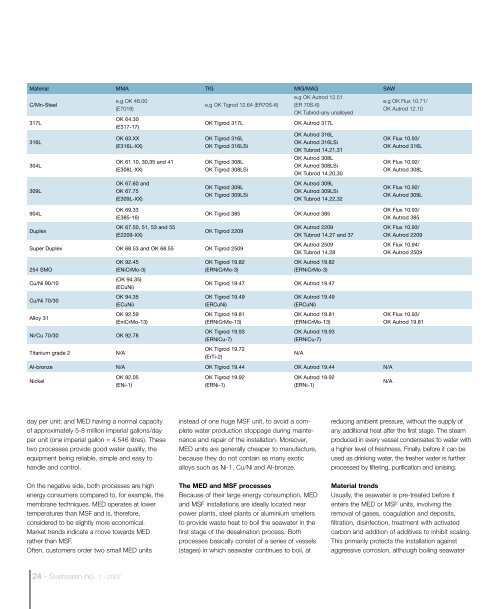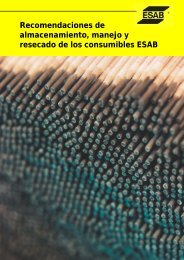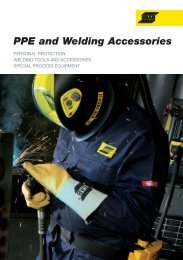Create successful ePaper yourself
Turn your PDF publications into a flip-book with our unique Google optimized e-Paper software.
Material MMA TIG MIG/MAG SAW<br />
C/Mn-Steel<br />
317L<br />
316L<br />
304L<br />
309L<br />
e.g OK 48.00<br />
(E7018)<br />
OK 64.30<br />
(E317-17)<br />
OK 63.XX<br />
(E316L-XX)<br />
OK 61.10, 30,35 and 41<br />
(E308L-XX)<br />
OK 67.60 and<br />
OK 67.75<br />
(E309L-XX)<br />
e.g OK Tigrod 12.64 (ER70S-6)<br />
OK Tigrod 317L<br />
OK Tigrod 316L<br />
OK Tigrod 316LSi<br />
OK Tigrod 308L<br />
OK Tigrod 308LSi<br />
OK Tigrod 309L<br />
OK Tigrod 309LSi<br />
e.g OK Autrod 12.51<br />
(ER 70S-6)<br />
OK Tubrod-any unalloyed<br />
OK Autrod 317L<br />
OK Autrod 316L<br />
OK Autrod 316LSi<br />
OK Tubrod 14.21,31<br />
OK Autrod 308L<br />
OK Autrod 308LSi<br />
OK Tubrod 14.20,30<br />
OK Autrod 309L<br />
OK Autrod 309LSi<br />
OK Tubrod 14.22,32<br />
e.g OK Flux 10.71/<br />
OK Autrod 12.10<br />
OK Flux 10.93/<br />
OK Autrod 316L<br />
OK Flux 10.92/<br />
OK Autrod 308L<br />
OK Flux 10.92/<br />
OK Autrod 309L<br />
904L<br />
Duplex<br />
OK 69.33<br />
(E385-16)<br />
OK 67.50, 51, 53 and 55<br />
(E2209-XX)<br />
OK Tigrod 385 OK Autrod 385<br />
OK Tigrod 2209<br />
Super Duplex OK 68.53 and OK 68.55 OK Tigrod 2509<br />
254 SMO<br />
Cu/Ni 90/10<br />
Cu/Ni 70/30<br />
Alloy 31<br />
OK 92.45<br />
(ENiCrMo-3)<br />
(OK 94.35)<br />
(ECuNi)<br />
OK 94.35<br />
(ECuNi)<br />
OK 92.59<br />
(EniCrMo-13)<br />
Ni/Cu 70/30 OK 92.78<br />
Titanium grade 2<br />
N/A<br />
OK Tigrod 19.82<br />
(ERNiCrMo-3)<br />
OK Autrod 2209<br />
OK Tubrod 14.27 and 37<br />
OK Autrod 2509<br />
OK Tubrod 14.28<br />
OK Autrod 19.82<br />
(ERNiCrMo-3)<br />
OK Tigrod 19.47 OK Autrod 19.47<br />
OK Tigrod 19.49<br />
(ERCuNi)<br />
OK Tigrod 19.81<br />
(ERNiCrMo-13)<br />
OK Tigrod 19.93<br />
(ERNiCu-7)<br />
OK Tigrod 19.72<br />
(ErTi-2)<br />
OK Autrod 19.49<br />
(ERCuNi)<br />
OK Autrod 19.81<br />
(ERNiCrMo-13)<br />
OK Autrod 19.93<br />
(ERNiCu-7)<br />
N/A<br />
OK Flux 10.93/<br />
OK Autrod 385<br />
OK Flux 10.93/<br />
OK Autrod 2209<br />
OK Flux 10.94/<br />
OK Autrod 2509<br />
OK Flux 10.93/<br />
OK Autrod 19.81<br />
Al-bronze N/A OK Tigrod 19.44 OK Autrod 19.44 N/A<br />
Nickel<br />
OK 92.05<br />
(ENi-1)<br />
OK Tigrod 19.92<br />
(ERNi-1)<br />
OK Autrod 19.92<br />
(ERNi-1)<br />
N/A<br />
day per unit; and MED having a normal capacity<br />
of approximately 5-8 million imperial gallons/day<br />
per unit (one imperial gallon = 4.546 litres). These<br />
two processes provide good water quality, the<br />
equipment being reliable, simple and easy to<br />
handle and control.<br />
instead of one huge MSF unit, to avoid a complete<br />
water production stoppage during maintenance<br />
and repair of the installation. Moreover,<br />
MED units are generally cheaper to manufacture,<br />
because they do not contain as many exotic<br />
alloys such as Ni-1, Cu/Ni and Al-bronze.<br />
reducing ambient pressure, without the supply of<br />
any additional heat after the first stage. The steam<br />
produced in every vessel condensates to water with<br />
a higher level of freshness. Finally, before it can be<br />
used as drinking water, the fresher water is further<br />
processed by filtering, purification and ionising.<br />
On the negative side, both processes are high<br />
energy consumers compared to, for example, the<br />
membrane techniques. MED operates at lower<br />
temperatures than MSF and is, therefore,<br />
considered to be slightly more economical.<br />
Market trends indicate a move towards MED<br />
rather than MSF.<br />
Often, customers order two small MED units<br />
The MED and MSF processes<br />
Because of their large energy consumption, MED<br />
and MSF installations are ideally located near<br />
power plants, steel plants or aluminium smelters<br />
to provide waste heat to boil the seawater in the<br />
first stage of the desalination process. Both<br />
processes basically consist of a series of vessels<br />
(stages) in which seawater continues to boil, at<br />
Material trends<br />
Usually, the seawater is pre-treated before it<br />
enters the MED or MSF units, involving the<br />
removal of gases, coagulation and deposits,<br />
filtration, disinfection, treatment with activated<br />
carbon and addition of additives to inhibit scaling.<br />
This primarily protects the installation against<br />
aggressive corrosion, although boiling seawater<br />
24 - <strong>Svetsaren</strong> no. 1 - <strong>2007</strong>




